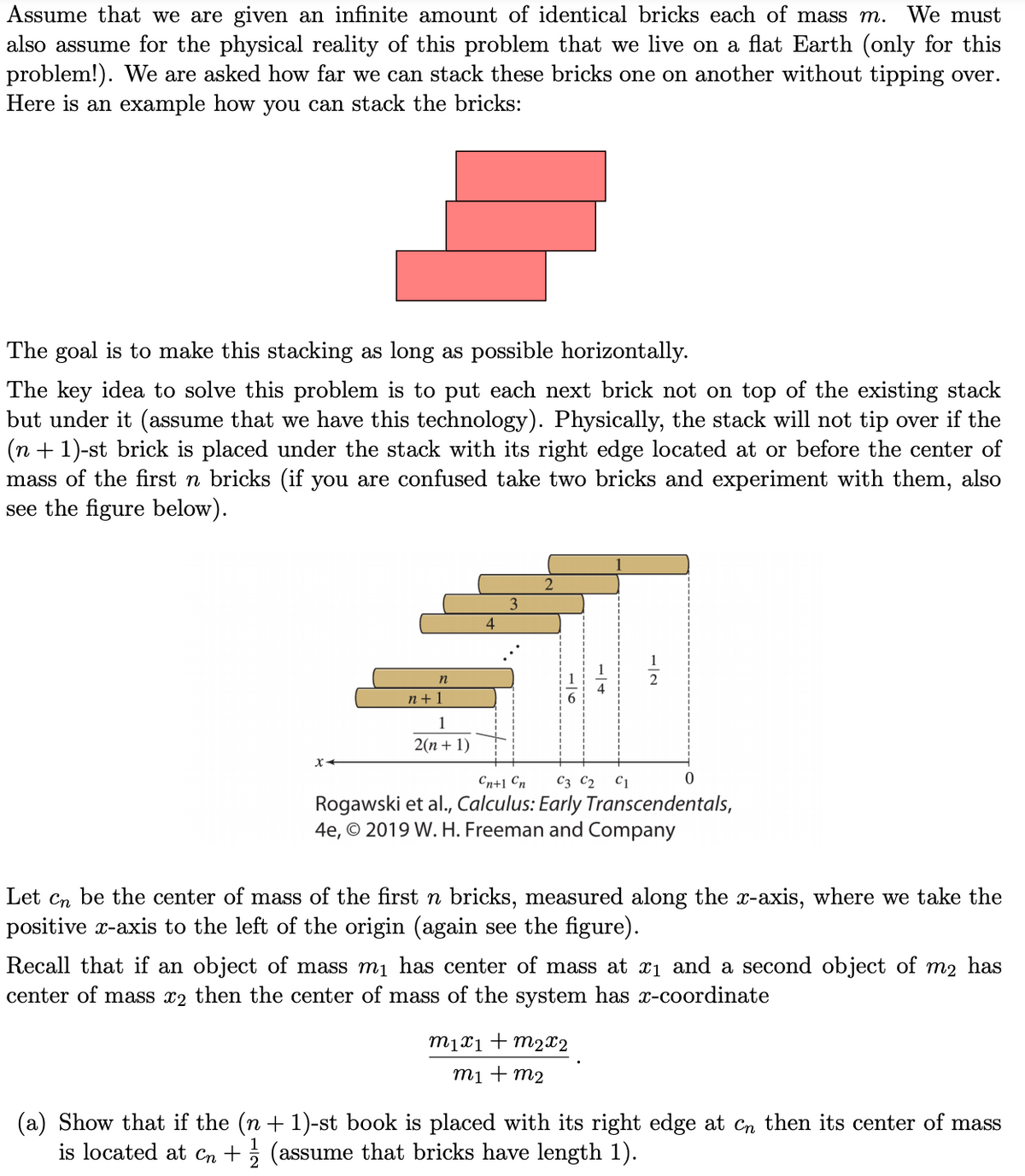(a) Show that if the (n + 1)-st book is placed with its right edge at cn then its center of mass is located at cn +5 (assume that bricks have length 1).
(a) Show that if the (n + 1)-st book is placed with its right edge at cn then its center of mass is located at cn +5 (assume that bricks have length 1).
Mathematics For Machine Technology
8th Edition
ISBN:9781337798310
Author:Peterson, John.
Publisher:Peterson, John.
Chapter63: Volumes Of Pyramids And Cones
Section: Chapter Questions
Problem 16A: A piece in the shape of a pyramid with a regular octagon (eight sided) base is machined from a solid...
Related questions
Question
Needing some help with A and B.

Transcribed Image Text:Assume that we are given an infinite amount of identical bricks each of mass m. We must
also assume for the physical reality of this problem that we live on a flat Earth (only for this
problem!). We are asked how far we can stack these bricks one on another without tipping over.
Here is an example how you can stack the bricks:
The goal is to make this stacking as long as possible horizontally.
The key idea to solve this problem is to put each next brick not on top of the existing stack
but under it (assume that we have this technology). Physically, the stack will not tip over if the
(n + 1)-st brick is placed under the stack with its right edge located at or before the center of
mass of the first n bricks (if you are confused take two bricks and experiment with them, also
see the figure below).
3
4
n
2
n+ 1
1
2(п + 1)
x-
Cn+1 Cn
C3 C2 C1
Rogawski et al., Calculus: Early Transcendentals,
4e, © 2019 W. H. Freeman and Company
Let cn be the center of mass of the first n bricks, measured along the x-axis, where we take the
positive x-axis to the left of the origin (again see the figure).
Recall that if an object of mass m1 has center of mass at x1 and a second object of m2 has
center of mass x2 then the center of mass of the system has x-coordinate
m1x1 + M2X2
mi + m2
(a) Show that if the (n + 1)-st book is placed with its right edge at cn then its center of mass
is located at cn +5 (assume that bricks have length 1).
2

Transcribed Image Text:(b) Consider the first n bricks as a single object of mass mn with center of mass at Cn and the
(n +1)-st brick as a second object of mass m. Find the x-coordinate of the center of mass
of this system if the right end of the (n+1)-st brick is at Cn. You should obtain a recursive
sequence of {cn}.
Expert Solution
This question has been solved!
Explore an expertly crafted, step-by-step solution for a thorough understanding of key concepts.
Step by step
Solved in 4 steps with 5 images

Knowledge Booster
Learn more about
Need a deep-dive on the concept behind this application? Look no further. Learn more about this topic, advanced-math and related others by exploring similar questions and additional content below.Recommended textbooks for you

Mathematics For Machine Technology
Advanced Math
ISBN:
9781337798310
Author:
Peterson, John.
Publisher:
Cengage Learning,

Algebra: Structure And Method, Book 1
Algebra
ISBN:
9780395977224
Author:
Richard G. Brown, Mary P. Dolciani, Robert H. Sorgenfrey, William L. Cole
Publisher:
McDougal Littell

Algebra & Trigonometry with Analytic Geometry
Algebra
ISBN:
9781133382119
Author:
Swokowski
Publisher:
Cengage

Mathematics For Machine Technology
Advanced Math
ISBN:
9781337798310
Author:
Peterson, John.
Publisher:
Cengage Learning,

Algebra: Structure And Method, Book 1
Algebra
ISBN:
9780395977224
Author:
Richard G. Brown, Mary P. Dolciani, Robert H. Sorgenfrey, William L. Cole
Publisher:
McDougal Littell

Algebra & Trigonometry with Analytic Geometry
Algebra
ISBN:
9781133382119
Author:
Swokowski
Publisher:
Cengage